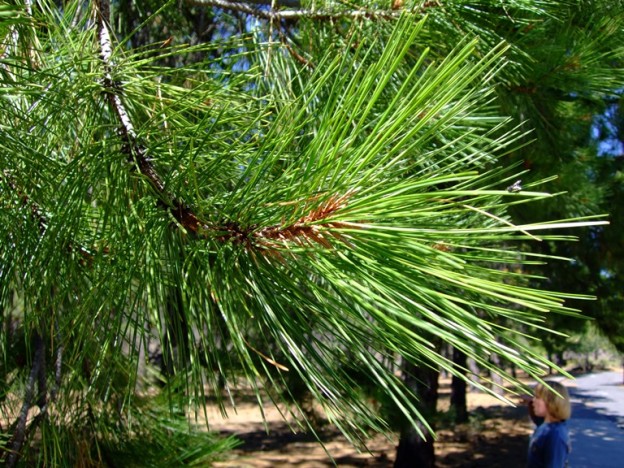Ponderosa Pine The Pine Family–Pinaceae
Pinus ponderosa C. Lawson
(PIE-nus pon-der-OH-suh)
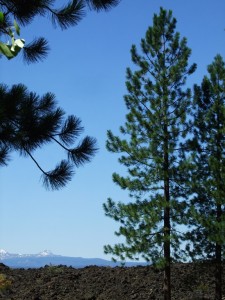 Names: Our 3-needled pine is the Ponderosa Pine, sometimes called the Western Yellow Pine. For most of us who grew up in the 60’s and 70’s the word “Ponderosa” elicits memories of Hoss and Little Joe Cartwright, characters in the TV show Bonanza. The Ponderosa Ranch near Lake Tahoe in the Sierra Nevadas was the setting for the show, possibly derived from the Ponderosa Pines in the area. The word “Ponderosa” means big or heavy.
Names: Our 3-needled pine is the Ponderosa Pine, sometimes called the Western Yellow Pine. For most of us who grew up in the 60’s and 70’s the word “Ponderosa” elicits memories of Hoss and Little Joe Cartwright, characters in the TV show Bonanza. The Ponderosa Ranch near Lake Tahoe in the Sierra Nevadas was the setting for the show, possibly derived from the Ponderosa Pines in the area. The word “Ponderosa” means big or heavy.
Relationships: There are about 115 species of pines worldwide, 35 in North America. The needles of pines are borne in bundles (or fascicles). Pines are separated into two groups: soft pines, which usually have needles in bundles of 5; and hard pines, which usually have needles in bundles of 2 or 3. We have one common soft pine, (5-needled) and two common hard pines (one with 2 needles and one usually with 3 needles). Pinus ponderosa is a 3-needled pine.
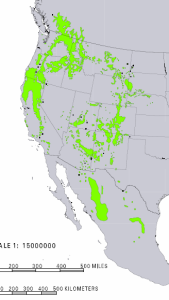
Distribution of Ponderosa Pine from USGS ( “Atlas of United States Trees” by Elbert L. Little, Jr. )
Distibution: Ponderosa Pine is common throughout the west, from British Columbia to California and Montana to Mexico. In the Pacific Northwest, we are most familiar with seeing these awesome trees on the eastern slope of the Cascade Mountains. They are also found on drier sites on the west side of the Cascades in Oregon. There is also a small population at Fort Lewis near Tacoma.
 Growth: The biggest Ponderosas surviving today are in the Sierra Nevadas and Siskiyous. The tallest are over 220 feet (65m) tall. Typically, they grow rapidly to 90-150 feet (30-45m) and live for about 600 years.
Growth: The biggest Ponderosas surviving today are in the Sierra Nevadas and Siskiyous. The tallest are over 220 feet (65m) tall. Typically, they grow rapidly to 90-150 feet (30-45m) and live for about 600 years.
Habitat: Mature Ponderosa Pines are very fire resistant due to their thick bark and high crowns. Smaller trees and underbrush are more susceptible. That is one reason why mature trees are often found in dry, open grassy sites where fires are common.
Wetland designation: FACU-, Facultative upland, it usually occurs in non-wetlands.
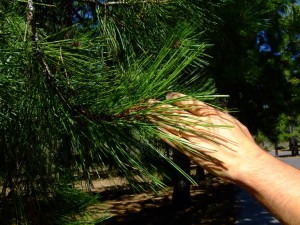 Diagnostic Characters: These trees are easily recognized by their cinnamon-colored bark that breaks apart in large jigsaw puzzle-like pieces. The needles form tufts at the end of branches and are usually in bundles of three, but sometimes there may only be two in a bundle. The cones are 3 to 6 inches long with each scale tipped with a stiff prickle.
Diagnostic Characters: These trees are easily recognized by their cinnamon-colored bark that breaks apart in large jigsaw puzzle-like pieces. The needles form tufts at the end of branches and are usually in bundles of three, but sometimes there may only be two in a bundle. The cones are 3 to 6 inches long with each scale tipped with a stiff prickle.
In the Landscape: A Ponderosa Pine may be too big for a small garden, but it can make an impressive addition to a large garden or park.
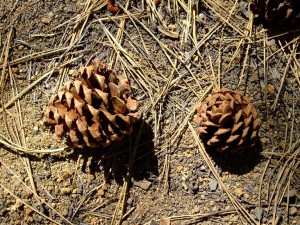 Phenology: Bloom Period: May to Mid-June. Cones mature in August the following year; seed dispersal begins in September.
Phenology: Bloom Period: May to Mid-June. Cones mature in August the following year; seed dispersal begins in September.
Propagation is easy by seed. The cones need to be collected before they open and allowed to dry. Once the cones open, the seeds can be shaken out. Stratify at 40ºF (4ºC) for 60 days. As with other pine species, cuttings are possible only when taken from very young trees.
Use by People: As a timber tree, it is perhaps second only to Douglas Fir in current use. Knotty pine paneling is made from young ponderosas. The colorful, mature wood has pale yellow to orange-brown heartwood with nearly white sapwood. It is used to make attractive wood furniture.
Use by Wildlife: Ponderosa Pine seeds are an extremely valuable food source for birds and squirrels. It is also a host plant for some butterflies. Nationwide, pines are second only to oaks in their food value to wildlife. In the Pacific region, pines are the most valuable. They have nutritious, oily seeds that are favored by many birds, especially Clark Nutcracker, crossbills, grosbeaks, jays, nuthatches, chickadees, and woodpeckers. Many small mammals, such as chipmunks and squirrels also eat the seeds. Foliage is eaten by grouse and deer. Porcupines and small rodents eat the bark and wood. Pine needles are a favorite material for making nests. Large pines provide excellent sites for roosting and nesting; small pines provide good cover for many animals.
Links:
Consortium of Pacific Northwest Herbaria
WTU Herbarium Image Collection, Plants of Washington, Burke Museum
E-Flora BC, Electronic Atlas of the Flora of British Columbia
Jepson Manual, University of California
Ladybird Johnson Wildflower Center
USDA Forest Service-Fire Effects Information System
Virginia Tech ID Fact Sheet + Landowner Fact Sheet
Native Plants Network, Propagation Protocol Database
Native American Ethnobotany, University of Michigan, Dearborn

